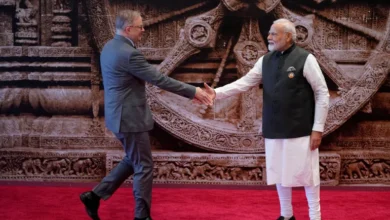ICC Cricket World Cup 2023: Can the sport finally go global?

Packed stadiums. Raucous crowds. Hooting vuvuzelas. The stage is set for cricket’s biggest carnival, which kicks off in India on October 5 with 10 nations competing for the World Cup over six weeks.
On the surface, the numbers suggest a global event: With over one billion fans, cricket is among the world’s most popular sports. But almost five centuries after the earliest recorded reference to cricket in southeast England, the sport’s market largely remains limited to a handful of countries, led by India.The sport spread with the British Empire, with the first international matches played in the second half of the 19th century. Yet, even as cricket has evolved over the years with changes in rules and the introduction of new formats and competitions, it has struggled to expand its reach beyond Commonwealth countries.
India, Australia and England dominate as cricketing powerhouses on the field while also holding significant positions of power off the field in the governance structures of the sport. Apart from the ‘Big Three’, other major cricketing nations include Pakistan, New Zealand, Sri Lanka, South Africa, Bangladesh and Caribbean countries that play together as the West Indies.
And that’s about it.
Football’s governing body FIFA boasts more than 200 member nations. The International Cricket Council (ICC), by contrast, has only 12 full members, with dozens of other nations as associate members.
The 50-over World Cup, for long cricket’s marquee event, has swung between accommodating more teams – a record 16 participated in the 2007 edition – and limiting participation to a select band of top-performing nations, as will be the case this time around.
The next edition, in 2027, will see 14 teams battle it out, but that’s still a much smaller number than the 32 nations that have competed in the football World Cup since 1998. In fact, 48 will feature in the next football World Cup in 2026.
So, can the World Cup fire up interest in cricket beyond countries that already love the sport? Or are shorter formats, like 20-overs-a-side competitions – known as Twenty20 (T20) cricket – the vehicles that can propel support around the world? Does cricket even have a global future?
The short answer: Cricket does have scope to grow, but it is unlikely to become a global phenomenon anytime soon. And more than the 50-over World Cup, it is the three-hour spectacle of T20 cricket that is the way forward, say experts, especially with the emergence of franchise leagues in new markets such as the United States. Women’s cricket can also help improve the sport’s global footprint, while a possible return to the Olympic Games might serve as a boost.Why has cricket not become global yet?
Unlike football, playing cricket involves high expenditure – be it buying the necessary gear, setting up stadiums or maintaining pitches.“Cricket has a relatively high barrier to entry compared to most sports, simply due to the level of equipment required to play even a recreational game,” said Matt Roller, assistant editor at the ESPNCricinfo website. “In my view, that is the principal reason that football has long been a global sport: All you need is a ball and any small space.”
But there are other reasons, too, behind cricket’s failure – by and large – to expand beyond its traditional markets, believe some experts.Jamie Alter, a cricket analyst and journalist, said that cricket’s foundations in colonialism mean the very fabric of the sport is tied to Commonwealth countries. “The game is too intrinsic to the cultures of most of these countries, and despite the efforts of the ICC to expand cricket across the globe, it remains a rather limited sport since it relies on too few countries to properly thrive and expand,” Alter said.
Traditionally cricket-loving nations like India, Pakistan and Bangladesh alone constitute a market of nearly two billion people.
“Even more insular is the strength of cricket from a commercial perspective,” he added, referring to the economic clout of India and developed cricket-playing countries like England and Australia. That insularity can blunt any sense of urgency to expand the sport’s reach among administrators.
Still, it isn’t as though the pool of nations that play cricket has remained entirely stagnant.
Though there are records of the British playing cricket in Afghanistan in the 19th century, the sport really took off in the war-torn nation among refugees who played in camps in Pakistan in the past two decades.
Then, in its first-ever 50-over World Cup in 2015, the Afghan side beat Scotland. In 2019, the country received test status – the pinnacle of the sport – and soon defeated two other test nations: Bangladesh and fellow greenhorn, Ireland. Afghan players are now regulars in T20 franchise leagues across the world.
But there is little to suggest that the sport’s bosses have plans in place to replicate Afghanistan’s success. In fact, some experts believe that administrators are wary of upstart teams upsetting major nations with big markets, especially in events like the World Cup.‘Growing very slowly’
Cricket World Cups have often attracted criticism over their small pool of participating teams. The World Cups are poorly designed – too long and with too few teams – said Tim Wigmore, deputy cricket correspondent for The Daily Telegraph newspaper. The 10-team World Cup in India will have 48 matches spanning 46 days. The 2022 football World Cup in Qatar had 32 teams and yet ran for less than a month.
“Cricket has been incredibly conservative in the number of teams it has allowed in World Cups,” Wigmore, co-author of the book Crickonomics, said.
And the reasons are not entirely innocent, according to him.
In 2007, the 50-overs World Cup had 16 teams. But Ireland defeated Pakistan and Bangladesh beat India, pushing the South Asian nations out of the competition at the group stage. Wigmore believes the number of participating nations was “perversely” reduced in subsequent tournaments “to ensure that sides from bigger markets had more games”.










